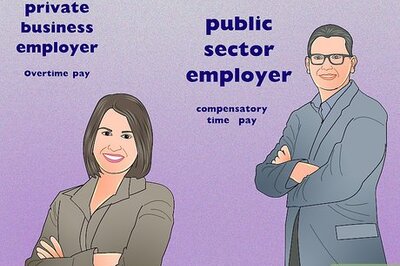
views
New York: As a US economic rebound stalls and threatens to spiral into recession, oil demand in the world's top consumer may be slipping into an irreversible decline. Last year's fledgling recovery in US oil usage - when demand rose 400,000 barrels per day (bpd) - made up for only a part of the 1 million bpd demand drop during a year of economic turmoil that began in August 2008.
Until recently, most analysts believed a healthier economy would push US oil use higher this year and next, before tighter environmental regulations, increased use of biofuels, and tougher fuel-efficiency standards kick in later this decade to lower demand permanently. Instead, a sour economy may turn last year's demand growth into a one-off.
With US manufacturing and service sectors slowing, a recent S&P downgrade on US debt, and a series of stock market falls that have rattled consumer confidence, the odds are tilting toward short-term declines as well. Last week, the US Department of Energy lowered its forecast for US oil demand from growth to decline in 2011.
It also cut its forecasts for growth in global oil demand, as did the Organization of the Petroleum Exporting Countries and the International Energy Agency.
"We see US oil demand falling this year and, later, settling into steady declines after 2015," said Rick Mueller of Boston-based consultant Energy Security Analysis Inc. "It's all about the transportation sector, and the trends point to lower oil use."
US mandates require 36 billion gallons of renewables like ethanol be blended into motor fuel by 2022, up from 14 billion gallons this year. The Obama administration has also boosted fuel economy standards for passenger vehicles to 54.5 miles per gallon by 2025, more than double current standards.
Limp demand in the United States and Western Europe won't fully offset growth in developing countries like China and India, whose appetite for crude nearly guarantees world demand will keep climbing.
Last year's US growth accounted for less than one-fifth of the rise in global oil demand, which was up 2.3 million barrels per day. But with the US still burning more than 19 million bpd - twice that of No 2 oil consumer China - slower demand here could further hammer US oil futures , which have already fallen by one-quarter since hitting $114 a barrel in April.
Until the recent slowdown, consensus forecasts saw US oil demand up around 100,000 bpd this year as GDP grew about 2.5 per cent, said Adam Sieminski of Deutsche Bank.
"If you take that GDP estimate to 1.5 per cent instead, it could leave no growth in US oil demand." The latest government data shows US oil demand, which looked buoyant earlier this year, slipped from year-ago levels in each of the last four months as pump prices climbed. Gasoline use in July was the lowest on record for the month, according to MasterCard data.
Less demand may wrongfoot oil market bulls like Goldman Sachs, which continues to call for oil prices to surpass 2011 highs next year, as demand expands faster than output. "For a long time the premise has been that demand growth will outpace supply, but it might be the other way around," said Tim Evans of Citi Futures in New York.
Barring an acute double-dip recession, few analysts expect US demand to repeat the radical declines of 2008 or 2009. Last year, US demand rose for only the first time since 2005 when it peaked at 20.8 million bpd, but had still fallen more than 8 per cent since then.
"Demand is reaching a plateau, and is then likely to fall slowly," said Mueller. Higher unemployment since 2007 has cut US vehicle miles travelled by about 2 per cent, said James Coan at Rice University's Baker Institute in Houston.
Americans without jobs drive about 55 per cent less, Coan said. Sunoco Inc, the Northeast's top independent oil refiner, has been particularly blunt about the long-term outlook for its main business. "We do not have a bullish outlook on refining," Chief Executive Lynn Elsenhans told investors on an early August conference call.
The silver lining for consumers is that retail US gasoline prices are expected to fall further from levels above $4 a gallon earlier this summer. Wholesale gasoline futures have already dropped 19 per cent since late April highs, and the reductions should trickle down to consumers soon.
According to Peter Beutel of energy consultancy Cameron Hanover in Connecticut, if recently lower wholesale prices hold, they could amount to savings of $115 billion over a year for drivers.
But recent history shows that even sharply falling pump prices can't resuscitate US demand during a downturn. Between mid-2008 and mid-2009, oil use dropped by a million barrels a day, even as gasoline prices cooled by 30 per cent.


















Comments
0 comment